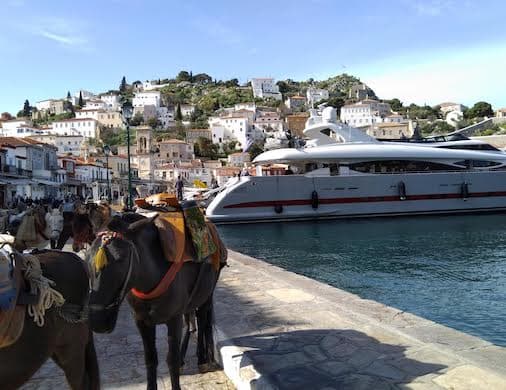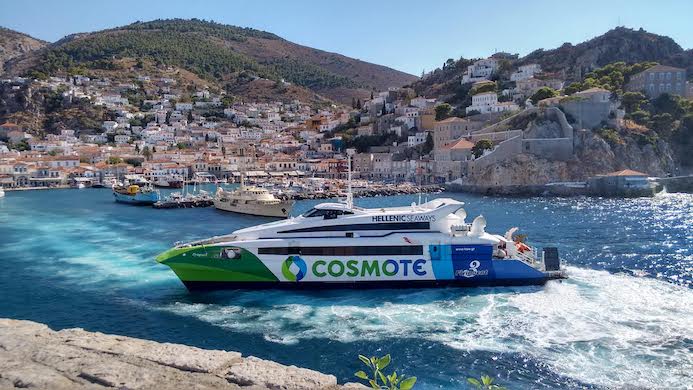Finding the Ghosts of Leonard Cohen and Greek Heroes, Plus a Few Donkeys, on the Island of Hydra
‘He traveled so far for beauty,’ reads a tiny plaque to Cohen near a ravishing view of the indigo Myrtoan Sea, as this bit of the Mediterranean is called locally.

Whether it’s climate change or just how things go, Greek summers have been getting hotter. Whoever can decamp to an island does so, and one that is much in vogue lately is Hydra, though my own affinity for it is tempered with ambivalence.
As the ferry from Piraeus pulls into the spectacular harbor, the island’s only town seems to whirl amphitheatrically into place above the cobalt water, but the austere façades of the old sea captains’ mansions, all silvery and sober, strike me as expressionless to the point of unsmiling. Dramatic, but also a little unnerving.
The picture is softened by the line of festively adorned donkeys waiting by water’s edge to take visitors wherever they might need to go — cars are verboten here — and there are other welcoming signs, like the strapatsada (an egg, tomato, and feta cheese number) at Papagalos café or a dish of homemade lemon ice cream enjoyed portside. Because one doesn’t need an airport to travel to Hydra, and because the breeze coming off the Aegean beats the hot stale air of the Athens metro, one goes.

At 19 square miles, Hydra is too small for anything of import to be hidden for very long. While the landscapes and quiet coves do their bit to temper any historical heaviness, the island is very conscious of its past, and of its artistic muscle.
Leonard Cohen had a house here; I am generally more drawn to places where high priests of pop or poetry do not have houses, and yet: “He traveled so far for beauty,” reads a tiny plaque to Cohen near a ravishing view of the indigo Myrtoan Sea, as this bit of the Mediterranean is called locally. A fool could argue with that, but I wouldn’t dare.
Hydra’s Greek pedigree runs very deep, and there is no better introduction to it than the Historical Archives-Museum of Hydra, housed in a stern-looking building next to the port that is not as old as it may seem; it dates from 1996. Inside, there are archives that document particularly well the more consequential goings-on of the 18th and 19th centuries here, as well as ships’ figureheads and ornamental carvings from the Greek War of Independence.
The museum’s collection may completely draw you in, but it’s wise to leave some time for whatever temporary art exhibition is also on hand; a recent one featured colorful works from the late Greek painter Alekos Fassianos’s French period. The duality of this institution — which by the way has a great little bookstore — speaks to the twin pillars of the Hydriot personality today: a sense of history and an embrace of contemporary cultural currents.
In summer you come for the easy swims and long meals in seaside tavernas, but the timeless appeal of Mediterranean lassitude notwithstanding, in Hydra there is no escaping culture. The billionaire Cypriot collector Dakis Joannou has helped see to that. His yacht, the Guilty, was painted by Jeff Koons and is often seen cutting its kaleidoscopic figure in Hydra’s harbor. Mr. Joannou in recent years installed an outpost of his Athens-based DESTE contemporary art foundation in a disused slaughterhouse on the island.
The project space has on view now the exhibition “Jeff Koons: Apollo,” the centerpiece of which is a nearly 8-foot-tall, polychromed animatronic sculpture of the sun god playing a kithara, the ancient Greek antecedent of the guitar. The setting — a squat stone building facing the sea — may seem an unlikely one for cutting-edge art, but on this quixotic island shaped like a cigar it somehow computes. Surfers and sybarites will likely find more succor in other archipelagos.
The School of Fine Arts clings to a steep hill on one side of the harbor and occupies the three-story Tombazis Mansion. Now owned by the University of Athens, the mansion belonged to Iakovos Tombazis, an admiral of the Hydriot fleet and an important figure in the Revolution of 1821. Hydra has about 30 mansions from the 18th century and about 300 homes that once belonged to sea captains. Another notable one is the Tsamadou Mansion, close to IAMY and which now houses the Greek Maritime Academy.
I did not see the house of a legendary Hydriot naval captain, Antonis Oikonomou, but I can’t say I didn’t feel his presence. Oikonomou prodded Hydra to join the rebellion against Ottoman rule in 1821 at a moment when that was not a universally popular position to stake out, and it cost him his life. Hydra ended up playing a vital role in the war, thanks to its 150 ships. In between the tourist cafés and winding lanes of Hydra’s town, there are still a few ghosts.
There’s also at least a trace of Jackie Kennedy (pre-Onassis). Saunter up some of the whitewashed alleys beyond the bobbing boats of the port and chances are good that, as I did, you’ll stumble upon the white façade of the Rafalia Pharmacy, which has been around since 1890 and aesthetically speaking hasn’t changed much since then. The walls opposite the vintage, glass-paneled wooden cabinet are plastered with simply framed black-and-white photos of famous visitors, including the former first lady, who visited Hydra on her solo trip to Greece in the summer of 1961.
The following year, cinema-goers were treated to scenes of Hydra shot in quite vivid black-and-white by director Jules Dassin in his version of the myth of Phaedra, starring Melina Mercouri and Anthony Perkins. That movie could make you think twice about marrying a shipping tycoon, should the opportunity arise.
The 1960s saw many a tycoon and boldfaced name like Leonard Cohen sidling up to the bar at Lagoudera, the mythic night spot that, like much of what put Hydra on the hipster hideaway circuit, no longer exists.
Hydra does still excel in providing some unadulterated small-island atmosphere. There are wonderfully scenic views and the unique chance to experience them without the clamor of cars and noisy motorbikes. One of the most dazzling promenades is also the easiest, starting at Hydronetta Beach Bar. The island is not known for its beaches, but there are plenty of little jetties from which you can plunge into some deliciously clear water.
The north side of the island, plunked as it is behind the tall ridge that spans Hydra from one narrow end to the other, may as well be the dark side of the moon, though a small luxury hotel did open there recently. No matter: You can get that feeling of splendid seclusion by ambling farther along on the south (harbor) side, west toward the seaside village of Vlichos. As you do, you’ll always have the shimmering sea on one side, down below, and on the other rocky hills sprinkled with cypress and olive trees, with bright pops of green that you won’t see on islands such as Mykonos.
Back at the harbor, the higher you climb, the more you seem to float above the hushed chorus line of red-tiled rooftops, and even the yachts begin to look like the toys that they pretty much are. There are hiking trails in the higher reaches for the ambitious, but you might want to hold out for cooler temperatures before taking on slopes of Eros, Hydra’s highest peak. In Hydra anyway, the most valuable real estate is really that shimmering blue water.

